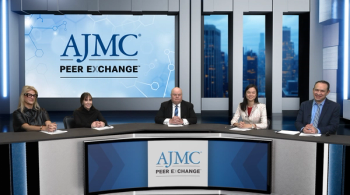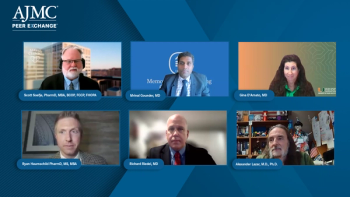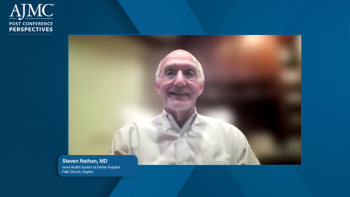
Understanding Treatment Risks, Benefits, and Value in Diabetic Macular Edema
Peter Salgo, MD: If we take all of these therapies, we’ve got the surgery, laser, steroids, and anti-vascular endothelial growth factors. Walk me through the risks and the benefits of each of these.
John W. Kitchens, MD: Any time you’re giving an injection in the eye, which is how we administer both steroids and the anti-vascular endothelial growth factor therapies, you have a risk of infection. That risk is anywhere on the order of 1-in-1000 to 1-in-5000. So that’s the number one thing.
You can also damage the lens, cause a cataract, cause retinal detachment. And that’s really where seeing a retina specialist makes a difference. If you’ve got someone who’s giving 30 or 40 of these injections a day, they’re going to be more skilled at it than someone who’s giving two or three of them every week.
When it comes to laser, obviously it’s inadvertent laser that can damage the area of synervision. Sometimes we’re lasering right around the fovea, or the area responsible for your crisp, middle vision. And if you hit that at the wrong time or the wrong area, you can cause a scotoma or blind spot in that patient’s eye.
And then, finally, surgery is the highest risk. That’s why we reserve it for last. The biggest complication with surgery is those tend to be your worst patients. You can develop detached retina after surgery. You can develop high pressure, cataracts, and other things such as that.
Peter Salgo, MD: We come back to the fact that I heard you say that you need, sometimes, nine injections in the first year. And if I’m 120 miles away from the nearest specialist who can do that, that’s a real issue. It means you’ve got to go out there more. But what are the other factors, including accessibility, that affect the treatment that you choose for somebody?
John W. Kitchens, MD: Certainly if there’s a transportation issue, that’s the nice thing about having multiple different medications.
For example, steroids do have an extended duration in the eye compared to anti-vascular endothelial growth factor therapy. And, in some instances, they’ll last three to six months versus an anti-vascular endothelial growth factor injection, which may only last a month or two. They do have their side effects, which Rishi alluded to, with cataracts and glaucoma. But in those patients, it may be something to consider.
Peter Salgo, MD: What is your goal? Is your goal to get rid of diabetic macular edema down to zero? Is that the goal? And is it a rational goal?
John W. Kitchens, MD: It’s very controversial, even amongst retinal specialists. Some people say, “Look, we’re treating the patient, we’re treating their vision.” Others say, “We’re treating their optical coherence tomography scan,” which is a cross-sectional scan through the macula that shows us the swelling.
I personally think that the optical coherence tomography scan is the most objective evidence that we’re achieving our goal, and so I’ll watch that first and foremost. And then, if that improves but the vision doesn’t improve, then I’ll start to look for other reasons why it may not be improving.
Peter Salgo, MD: Is that your goal too? Or do you have a different answer?
Rishi P. Singh, MD: I totally agree. I think that one of the discussions we always have with the patient, and it’s difficult because I don’t know if they understand this—we’re preventing them from having severe vision loss that would occur a year, two years, or three years down the road. They might not necessarily understand why they’re getting the treatments now.
That’s again one of those disconnects between the education and what we do in clinical practice. So, I think part of that is we have to have that discussion with patients with regards to the outcomes and what we plan to achieve. Yes, you will get a fair number of injections, but the goal here is to preserve your vision, if not improve it. And we can improve it 45% of the time, three lines or more, and keep it stable 90% or more in most patients in the population.
Peter Salgo, MD: Compared to when I went to medical school, this is so new and so exciting. It’s really awe inspiring. And I would be willing to bet, more in your position, I would have trouble doing it. The same with hypertensive patients who don’t feel any problem until they have a stroke or a myocardial infarction. “I feel great doc, and you’re going to put a needle in my eye nine times?”
Rishi P. Singh, MD: The bigger problem is that if this patient is in front of you and you’re putting the needle in their eye nine times, they probably have nephropathy, they probably have neuropathy, and they probably have cardiovascular disease. I think that that’s the bigger thing we have to really discuss with patients.
I spend more of my time discussing the non-eye related issues in my clinical practice because I know more of this risk stratification of those patients in front of me with those sort of conditions than I do talking about the retinopathy scores, sometimes, because they seem to understand those things in a much more global fashion and get the gravity of that situation.
Peter Salgo, MD: With all of these therapies out there, and then within the vascular endothelial growth factor therapies, there’s got to be some sort of hierarchy, right? Some are more expensive, some are cheaper. How do you set up a stratification of what you’re going to pay for? How do you pay for it? What’s a doctor to do? What’s a patient to do?
Steven Peskin, MD, MBA, FACP: There are levers in place to encourage the initial use of, and as John said, that ability to read where one is with bevacizumab as a lower cost alternative.
That said, we do recognize, and our medical policy does reflect, the fact that sometimes there are preferred options and that’s where we need our clinical partners to step up and make that information known to us.
That’s sort of the give and take between the healthcare professionals. We absolutely recognize they have the superordinate knowledge, information, and insight, and then bring that knowledge, information, and insight to the forefront, usually with peer reviewed literature. This is much more appreciated or valued than my opinion.
Peter Salgo, MD: Superordinate is a heck of a word. I don’t think we’ve ever done superordinate in one of these panels before. Let me take a little grenade, pull the pin, and put it right here. Is he full of patoot or not?
John W. Kitchens, MD: No. I think a good insurance plan will give you access to the medical director who will listen, who’s a physician, who understands the literature. And this is probably not the first time they’ve heard these things. Insurances are tricky though. They have ways of influencing.
One of the ways that’s probably the most frustrating as a physician is tiered therapy, not so much the fact that they dictate to us that, “You have to start with this treatment.” Typically it’s bevacizumab, but it’s when they define failure. And some of these will say it’s six months of continuous bevacizumab and less than two lines of improvement. And you look at the patient’s scan and they still have treatable edema that’s not responding anymore to it. And those are the ones that are really frustrating.
Peter Salgo, MD: I get a sense also that you’re losing ground here. At some point you’re going to lose sight that you can regain.
John W. Kitchens, MD: If you don’t treat these patients early, you’re leaving vision on the table.
Peter Salgo, MD: Didn’t we already establish that early is better, aggressive is better, and the right drug would be better than the wrong drug? And if you consistently hear, “But the right drug is a little more expensive so we’re not going to pull that lever,” what are you going to do?
Rishi P. Singh, MD: You try to assimilate with what the insurance companies are asking you for. We develop systems in our facility to do that sort of thing. It’s not easy, and it’s not exciting or sexy, but it’s stuff that we do on a daily basis to ensure ourselves that we are getting paid for the drugs.
We preauthorize our patients a month ahead of time. For our patients who are going to the end of an expiration of their authorization to receive a certain drug, we’re submitting those claims a month ahead to make sure that they are not seeing any lapse of coverage and that we don’t have to go back to the other drug if we don’t want to. Those are methods that we’ve done, and electronic systems around it, to really hone in on what those options are.
Peter Salgo, MD: Let me take you two out of the equation. I’ll put myself into it. I’m going to make a phone call to the insurance company—“Are you kidding me? I got a better drug and it’s working but you won’t let me use it? Come on, insurance company. What’s wrong?” How’s that for a phone call? Does that work with you?
Steven Peskin, MD, MBA, FACP: Well, again, that’s where we’re going to say, “Doctor, in due respect, what is it that you can show me or the medical director who’s making this decision? That the best choice, the choice that’s been demonstrated, whether it be in randomized controlled trials or in longitudinal studies, that this is the preferred agent?”
Peter Salgo, MD: I’m going to give you his cell phone number. He’s got the data.
John W. Kitchens, MD: Here’s the thing. The problem really isn’t the 10% of doctors who will make that call and the medical director who will pick up the phone. The problem is the 90% who go, “Okay, fine, we’ll use whatever they want us to use and we’re just not doing what’s best for our patients.”
Peter Salgo, MD: We’re not getting them a dialogue at all. For this dialogue to occur, the odds are we could come to some sort of mutual or reasonable agreement.
Steven Peskin, MD, MBA, FACP: Yeah.
Peter Salgo, MD: So you want to talk to people.
Steven Peskin, MD, MBA, FACP: Yeah. The issues of appropriate use, versus overuse, versus misuse are very real. We see all of those. Most times it is appropriate use. Sometimes there is overuse. We were talking about the ‘belt and suspenders’ or excessive use. Then, there’s the issues of less effective care. That’s where we want to make sure that our clinicians are aware of the most effective care, or are making us aware of the most effective care.
Peter Salgo, MD: You know what the problem is? Everybody at this table sounds rational. So why do we sometimes come up with irrational solutions? What’s the problem?
Rishi P. Singh, MD: With the lack of evidence. Now we have evidence of studies and things like that. It was a hard place to be. And I think both companies and also clinicians have become savvy and have started producing and working on their own projects and research that has led to this sort of intervention and the ability to look at those sort of things.
Newsletter
Stay ahead of policy, cost, and value—subscribe to AJMC for expert insights at the intersection of clinical care and health economics.






































